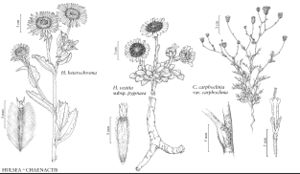Hulsea heterochroma
Proc. Amer. Acad. Arts 7: 359. 1867.
Common names: Redray alpinegold
IllustratedEndemic
Biennials or perennials, 50–150 cm. Stems 1–3, glandular. Leaves mostly cauline; blades green, broadly oblanceolate to spatulate, 9–21 cm, margins dentate, faces glandular-villous; distal cauline leaves lanceolate to ovate, gradually reduced. Heads 3–5. Involucres obconic to hemispheric, 11–18 mm diam. Phyllaries 10–25 mm, outer narrowly lanceolate, apices attenuate. Ray florets 28–75+; corolla tubes hairy, laminae red to reddish purple (narrowly oblong to linear, ciliate), 7–15 mm. Disc corollas yellow (lobes and veins red-tinged). Cypselae 6–8 mm; pappus scales unequal, shorter 1–2 mm, longer 2–3 mm. 2n = 38.
Phenology: Flowering late spring–summer.
Habitat: Often common after fires, chaparral and woodlands, rocky or gravelly soils from various substrates
Elevation: 300–2600 m
Distribution

Ariz., Calif., Nev., Utah.
Discussion
Selected References
None.
Lower Taxa
None.
